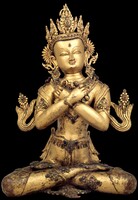Amoghapasha Main Page & Masterworks - Updated

Amoghapasha, which means unfailing lasso, refers to an unfailing compassion like a lasso which brings all sentient beings out of suffering and into a state of happiness leading to enlightenment. Amoghapasha is a complicated deity subject in Tantric Buddhist iconography. He is easily mistaken for Avalokiteshvara in most artistic depictions. The two deities are frequently conflated together by scholars. Sometimes Amoghapasha is described as a form, or emanation, of Avalokiteshvara and again at other times a retinue figure while Avalokiteshvara is the central deity in the mandala. It begs the question, why are some of these mandalas called the Five-deity Amoghapasha if the central deity is Avalokiteshvara? It all comes down to naming conventions in Buddhism. The very idea of a compassionate deity called Amoghapasha comes out of a number of Indian Sanskrit texts that all have the word-name Amoghapasha in the title. In these texts both Avalokiteshvara and Amoghapasha are described along with different appearances and functions for each. In consequence, the principal name for all of these forms of the two deities, regardless of which one of the two is at the center of the mandala, are called Amoghapasha - mandala, meditation, or ritual.
There are a number of different Amoghapasha mandala configurations that still exist in the Newar and Tibetan Buddhist Traditions. There are also numerous solitary forms that do not have elaborate mandalas or retinue figures. The most common of these forms are typically depicted in Nepalese sculpture. They generally have one face and multiple arms, six, eight or ten, and are shown in a standing posture. (See the Amoghapasha Forms Outline).
Amoghapasha Pages:
Amoghapasha Main Page
Outline Page
Forms of the Deity Outline
Painting Set Outline
Amoghapasha Masterworks














